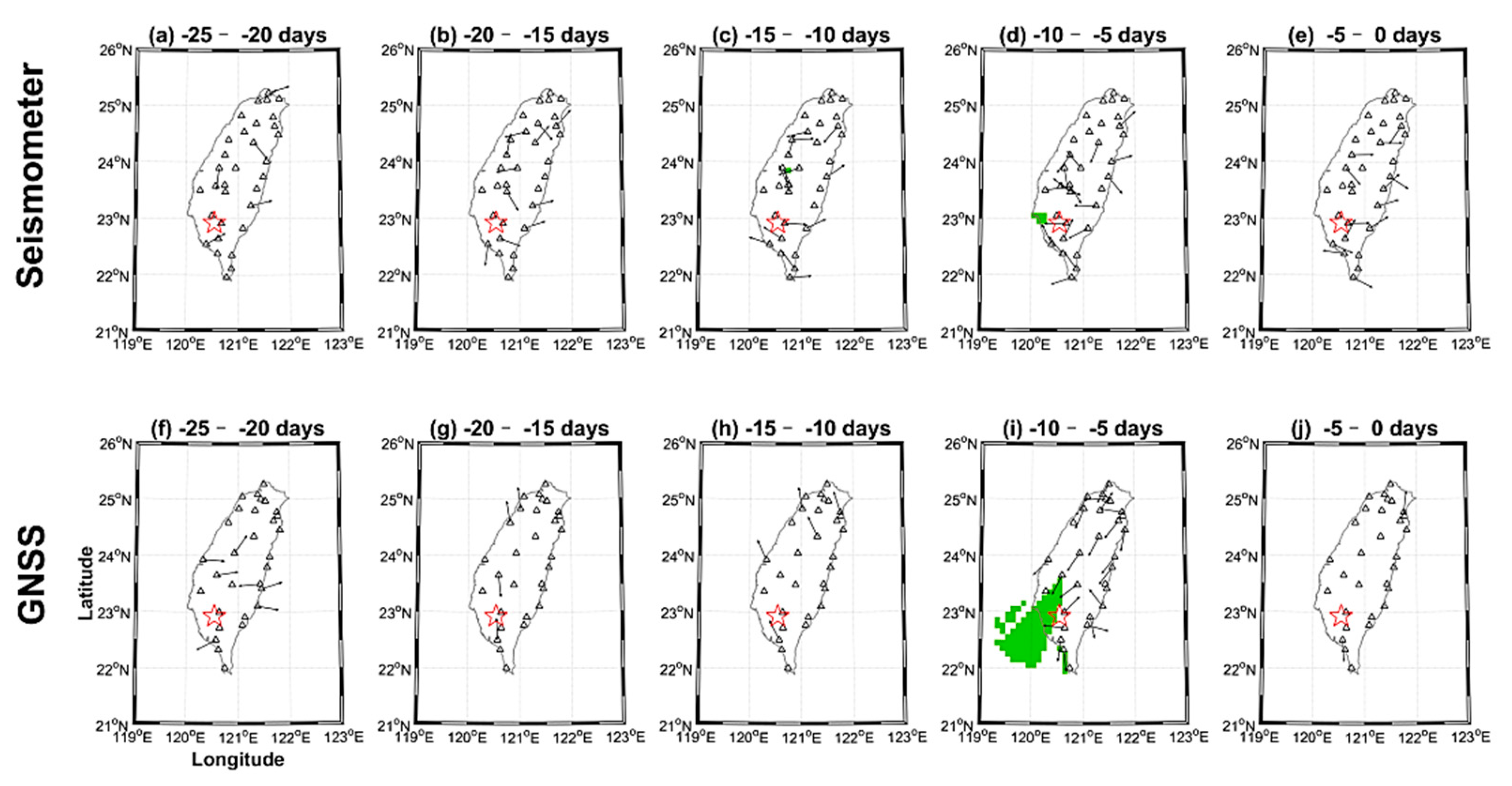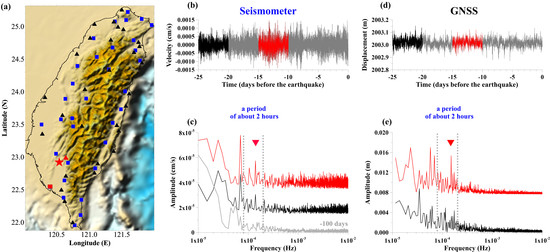Determination of Epicenters before Earthquakes Utilizing Far Seismic and GNSS Data: Insights from Ground Vibrations
Abstract
1. Introduction
2. Methodology
3. The Spatiotemporal Distribution and the Source Location of the Vibrations
4. The Principal Component Analysis and the Molchan’s Error Diagrams

| Year | Month | Day | Magnitude | Longitude (°E) | Latitude (°N) | Depth (km) | Days to the EQ |
|---|---|---|---|---|---|---|---|
| 16 | 2 | 5 | 6.6 | 120.544 | 22.922 | 14.6 | 0 |
| 16 | 5 | 12 | 6.1 | 121.980 | 24.692 | 8.9 | 96 |
5. Discussions and Conclusions
Supplementary Materials
Author Contributions
Funding
Data Availability
Acknowledgments
Conflicts of Interest
References
- Fraser-Smith, A.C.; Bernardi, A.; McGill, P.; Ladd, M.E.; Helliwell, R.; Villard, O.G., Jr. Low-frequency magnetic field measurements near the epicenter of the Ms 7.1 Loma Prieta earthquake. Geophys. Res. Lett. 1990, 17, 1465–1468. [Google Scholar] [CrossRef]
- Campbell, W.H. Natural magnetic disturbance fields, not precursors preceding the Loma Prieta earthquake. J. Geophys. Res. 2009, 114, A05307. [Google Scholar] [CrossRef]
- Uyeda, S.; Nagao, T.; Kamogawa, M. Short-term earthquake prediction: Current status of seismo-electromagnetics. Tectonophysics 2009, 470, 205–213. [Google Scholar] [CrossRef]
- Kappler, K.N.; Morrison, H.F.; Egbert, G.D. Long-term monitoring of ULF electromagnetic fields at Parkfield, California. J. Geophys. Res. 2010, 115, B04406. [Google Scholar] [CrossRef]
- Hattori, K.; Han, P.; Yoshino, C.; Febriani, F.; Yamaguchi, H.; Chen, C. Investigation of ULF seismo-magnetic phenomena in Kanto, Japan during 2000–2010: Case studies and statistical studies. Surv. Geophys. 2013, 34, 293–316. [Google Scholar] [CrossRef]
- Wang, T.; Zhuang, J.; Kato, T.; Bebbington, M. Assessing the potential improvement in short-term earthquake forecasts from incorporation of GPS data. Geophys. Res. Lett. 2013, 40, 2631–2635. [Google Scholar] [CrossRef]
- Han, P.; Hattori, K.; Hirokawa, M.; Zhuang, J.; Chen, C.; Febriani, F.; Yamaguchi, H.; Yoshino, C.; Liu, J.; Yoshida, S. Statistical analysis of ULF seismo-magnetic phenomena at Kakioka, Japan, during 2001–2010. J. Geophys. Res. Space Phys. 2014, 119, 4998–5011. [Google Scholar] [CrossRef]
- Hayakawa, M.; Kasahara, Y.; Nakamura, T.; Muto, F.; Horie, T.; Maekawa, S.; Hobara, Y.; Rozhnoi, A.A.; Solovieva, M.; Molchanov, O.A. A statistical study on the correlation between lower ionospheric perturbations as seen by subionospheric VLF/LF propagation and earthquakes. J. Geophys. Res. 2010, 115, A09305. [Google Scholar] [CrossRef]
- Sun, Y.Y.; Oyama, K.-I.; Liu, J.Y.; Jhuang, H.K.; Cheng, C.Z. The neutral temperature in the ionospheric dynamo region and the ionospheric F region density during Wenchuan and Pingtung Doublet earthquakes. Nat. Hazards Earth Syst. Sci. 2011, 11, 1759–1768. [Google Scholar] [CrossRef]
- Klimenko, M.V.; Klimenko, V.V.; Karpov, I.V.; Zakharenkova, I.E. Simulation of seismo-ionospheric effects initiated by internal gravity waves. J. Phys. Chem. B 2011, 5, 393–401. [Google Scholar] [CrossRef]
- Klimenko, M.V.; Klimenko, V.V.; Zakharenkova, I.E.; Karpov, I.V. Modeling of local disturbance formation in the ionosphere electron concentration before strong earthquakes. Earth Planets Space 2012, 64, 441–450. [Google Scholar] [CrossRef]
- Oyama, K.-I.; Devi, M.; Ryu, K.; Chen, C.-H.; Liu, J.-Y.; Liu, H.; Bankov, L.; Kodama, T. Modifications of the ionosphere prior to large earthquakes: Report from the Ionosphere Precursor Study Group. Geosci. Lett. 2016, 3, 6. [Google Scholar] [CrossRef]
- Bedford, J.R.; Moreno, M.; Deng, Z.; Oncken, O.; Schurr, B.; John, T.; Báez, J.C.; Bevis, M. Months-long thousand-kilometre-scale wobbling before great subduction earthquakes. Nature 2020, 580, 628–635. [Google Scholar] [CrossRef] [PubMed]
- Chen, C.H.; Yeh, T.K.; Liu, J.Y.; Wang, C.H.; Wen, S.; Yen, H.Y.; Chang, S.H. Surface Deformation and Seismic Rebound: Implications and applications. Surv. Geophys. 2011, 32, 291–313. [Google Scholar] [CrossRef]
- Chen, C.H.; Tang, C.C.; Cheng, K.C.; Wang, C.H.; Wen, S.; Lin, C.H.; Wen, Y.Y.; Meng, G.; Yeh, T.K.; Jan, J.C.; et al. Groundwater-strain coupling before the 1999 Mw 7.6 Taiwan Chi-Chi earthquake. J. Hydrol. 2015, 524, 378–384. [Google Scholar] [CrossRef]
- Chen, C.H.; Yeh, T.K.; Wen, S.; Meng, G.; Han, P.; Tang, C.C.; Liu, J.Y.; Wang, C.H. Unique Pre-Earthquake Deformation Patterns in the Spatial Domains from GPS in Taiwan. Remote Sens. 2020, 12, 366. [Google Scholar] [CrossRef]
- Chen, C.H.; Su, X.; Cheng, K.C.; Meng, G.; Wen, S.; Han, P.; Tang, C.C.; Liu, J.Y.; Wang, C.H. Seismo-deformation anomalies associated with the M6.1 Ludian earthquake on August 3, 2014. Remote Sens. 2020, 12, 1067. [Google Scholar] [CrossRef]
- Mao, Z.; Chen, C.-H.; Zhang, S.; Yisimayili, A.; Yu, H.; Yu, C.; Liu, J.-Y. Locating Seismo-Conductivity Anomaly before the 2017 MW 6.5 Jiuzhaigou Earthquake in China Using Far Magnetic Stations. Remote Sens. 2020, 12, 1777. [Google Scholar] [CrossRef]
- Dragert, H.; Wang, K.; James, T.S. A Silent Slip Event on the Deeper Cascadia Subduction Interface. Science 2001, 292, 1525–1528. [Google Scholar] [CrossRef]
- Obara, K. Nonvolcanic Deep Tremor Associated with Subduction in south west Japan. Science 2002, 296, 1679–1681. [Google Scholar] [CrossRef]
- Kostoglodov, V.; Singh, S.K.; Santiago, J.A.; Franco, S.I.; Larson, K.M.; Lowry, A.R.; Bilham, R. A large silent earthquake in the Guerrero seismic gap, Mexico. Geophys. Res. Lett. 2003, 30, 157–168. [Google Scholar] [CrossRef]
- Rogers, G.; Dragert, H. Episodic Tremor and slip on the Cascadia Subduction Zone: The chatter of silent slip. Science 2003, 300, 1942–1943. [Google Scholar] [CrossRef] [PubMed]
- Shin, T.C.; Kuo, K.W.; Leu, P.L.; Tsai, C.H.; Jiang, J.S. Continuous CWB GPS array in Taiwan and applications to monitoring seismic activity. Terr. Atmos. Ocean. Sci. 2011, 22, 521–533. [Google Scholar] [CrossRef]
- Chung, Y.D.; Yeh, T.K.; Xu, G.; Chen, C.S.; Hwang, C.; Shih, H.C. GPS height variations affected by ocean tidal loading along the coast of Taiwan. IEEE Sens. J. 2016, 16, 3697–3704. [Google Scholar] [CrossRef]
- Yeh, T.-K.; Huang, C.; Xu, G. GPS height and gravity variations due to ocean tidal loading around Taiwan. Surv. Geophys. 2008, 29, 37–50. [Google Scholar] [CrossRef]
- Yeh, T.-K.; Hwang, C.-H.; Huang, J.-F.; Chao, B.F.; Chang, M.-H. Vertical displacement due to ocean tidal loading around Taiwan based on GPS observations. Terr. Atmos. Ocean. Sci. 2011, 22, 373–382. [Google Scholar] [CrossRef][Green Version]
- Tanimoto, T.; Ishimaru, S.; Alvizuri1, C. Seasonality in particle motion of microseisms. Geophys. J. Int. 2006, 166, 253–266. [Google Scholar] [CrossRef]
- Jolliffe, I.T. Principal Component Analysis; Springer: New York, NY, USA, 2002; ISBN 978-0-387-95442-4. [Google Scholar]
- Phanikumar, D.V.; Maurya, A.K.; Kumar, K.N.; Venkatesham, K.; Singh, R.; Sharma, S.; Naja, M. Anomalous variations of VLF subionospheric signal and Mesospheric Ozone prior to 2015 Gorkha Nepal Earthquake. Sci. Rep. 2018, 8, 9381. [Google Scholar] [CrossRef]
- Molchan, G.M. Structure of optimal strategies in earthquake prediction. Tectonophysics 1991, 193, 267–276. [Google Scholar] [CrossRef]
- Dobrovolsky, I.P.; Zubkov, S.I.; Miachkin, V.I. Estimation of the size of earthquake preparation zones. Pure Appl. Geophys. 1979, 117, 1025–1044. [Google Scholar] [CrossRef]
- Chen, C.H.; Wen, S.; Liu, J.Y.; Hattori, K.; Han, P.; Hobara, Y.; Wang, C.H.; Yeh, T.K.; Yen, H.Y. Surface displacements in Japan before the 11 March 2011 M9.0 Tohoku-Oki earthquake. J. Asian Earth Sci. 2014, 80, 165–171. [Google Scholar] [CrossRef]
- Walczak, P.; Mezzapesa, F.; Bouakline, A.; Ambre, J.; Bouissou, S.; Barland, B. Real time observation of granular rock analogue material deformation and failure using nonlinear laser interferometry. arXiv preprint 2017, arXiv:1705.03377v1. [Google Scholar]
- Leissa, A.W. Vibrations of Plates; Ohio State University: Columbus, OH, USA, 1969. [Google Scholar]
- Vilarrasa, V.; Carrera, J. Geologic carbon storage is unlikely to trigger large earthquakes and reactivate faults through which CO2 could leak. Proc. Natl. Acad. Sci. USA 2015, 112, 5938–5943. [Google Scholar] [CrossRef] [PubMed]
- Liu, J.Y.; Chen, Y.I.; Chen, C.H.; Liu, C.Y.; Chen, C.Y.; Nishihashi, M.; Li, J.Z.; Xia, Y.Q.; Oyama, K.I.; Hattori, K.; et al. Seismoionospheric GPS total electron content anomalies observed before the 12 May 2008 Mw 7.9 Wenchuan earthquake. J. Geophys. Res. 2009, 114, A04320. [Google Scholar] [CrossRef]
- Liu, J.Y.; Chen, C.H.; Sun, Y.Y.; Chen, C.H.; Tsai, H.F.; Yen, H.Y.; Chum, J.; Lastovicka, J.; Yang, Q.S.; Chen, W.S.; et al. The vertical propagation of disturbances triggered by seismic waves of the 11 March 2011 M9.0 Tohoku Earthquake over Taiwan. Geophys. Res. Lett. 2016, 43, 1759–1765. [Google Scholar] [CrossRef]






| Earthquake | Date | Location | Country or Areas |
|---|---|---|---|
| M6 Parkfield EQ | 28 September 2004 | 35.8° N, 120.4° W | United States |
| M7.2 Baja EQ | 4 April 2010 | 38.2° N, 122.3° W | Mexico |
| M6.6 Jinggu EQ | 7 October 2014 | 23.4° N, 100.5° E | China |
| M6.5 Ludian EQ | 3 August 2014 | 27.1° N, 103.3° E | China |
| M6.6 Meinong EQ | 6 February 2016 | 22.9° N, 120.5° E | Taiwan |
| M6.0 Hualien EQ | 6 February 2018 | 24.1° N, 121.7° E | Taiwan |
© 2020 by the authors. Licensee MDPI, Basel, Switzerland. This article is an open access article distributed under the terms and conditions of the Creative Commons Attribution (CC BY) license (http://creativecommons.org/licenses/by/4.0/).
Share and Cite
Chen, C.-H.; Lin, L.-C.; Yeh, T.-K.; Wen, S.; Yu, H.; Yu, C.; Gao, Y.; Han, P.; Sun, Y.-Y.; Liu, J.-Y.; et al. Determination of Epicenters before Earthquakes Utilizing Far Seismic and GNSS Data: Insights from Ground Vibrations. Remote Sens. 2020, 12, 3252. https://doi.org/10.3390/rs12193252
Chen C-H, Lin L-C, Yeh T-K, Wen S, Yu H, Yu C, Gao Y, Han P, Sun Y-Y, Liu J-Y, et al. Determination of Epicenters before Earthquakes Utilizing Far Seismic and GNSS Data: Insights from Ground Vibrations. Remote Sensing. 2020; 12(19):3252. https://doi.org/10.3390/rs12193252
Chicago/Turabian StyleChen, Chieh-Hung, Li-Ching Lin, Ta-Kang Yeh, Strong Wen, Huaizhong Yu, Chen Yu, Yongxin Gao, Peng Han, Yang-Yi Sun, Jann-Yenq Liu, and et al. 2020. "Determination of Epicenters before Earthquakes Utilizing Far Seismic and GNSS Data: Insights from Ground Vibrations" Remote Sensing 12, no. 19: 3252. https://doi.org/10.3390/rs12193252
APA StyleChen, C.-H., Lin, L.-C., Yeh, T.-K., Wen, S., Yu, H., Yu, C., Gao, Y., Han, P., Sun, Y.-Y., Liu, J.-Y., Lin, C.-H., Tang, C.-C., Lin, C.-M., Hsieh, H.-H., & Lu, P.-J. (2020). Determination of Epicenters before Earthquakes Utilizing Far Seismic and GNSS Data: Insights from Ground Vibrations. Remote Sensing, 12(19), 3252. https://doi.org/10.3390/rs12193252









